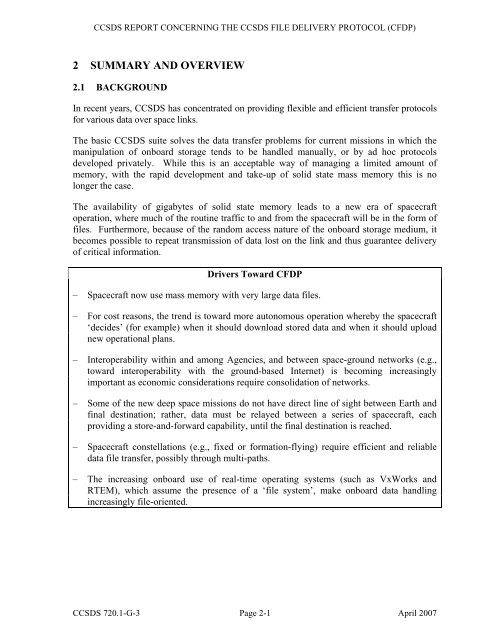CCSDS File Delivery Protocol (CFDP)âPart 1: Introduction and ...
CCSDS File Delivery Protocol (CFDP)âPart 1: Introduction and ...
CCSDS File Delivery Protocol (CFDP)âPart 1: Introduction and ...
Create successful ePaper yourself
Turn your PDF publications into a flip-book with our unique Google optimized e-Paper software.
<strong>CCSDS</strong> REPORT CONCERNING THE <strong>CCSDS</strong> FILE DELIVERY PROTOCOL (<strong>CFDP</strong>)<br />
2 SUMMARY AND OVERVIEW<br />
2.1 BACKGROUND<br />
In recent years, <strong>CCSDS</strong> has concentrated on providing flexible <strong>and</strong> efficient transfer protocols<br />
for various data over space links.<br />
The basic <strong>CCSDS</strong> suite solves the data transfer problems for current missions in which the<br />
manipulation of onboard storage tends to be h<strong>and</strong>led manually, or by ad hoc protocols<br />
developed privately. While this is an acceptable way of managing a limited amount of<br />
memory, with the rapid development <strong>and</strong> take-up of solid state mass memory this is no<br />
longer the case.<br />
The availability of gigabytes of solid state memory leads to a new era of spacecraft<br />
operation, where much of the routine traffic to <strong>and</strong> from the spacecraft will be in the form of<br />
files. Furthermore, because of the r<strong>and</strong>om access nature of the onboard storage medium, it<br />
becomes possible to repeat transmission of data lost on the link <strong>and</strong> thus guarantee delivery<br />
of critical information.<br />
Drivers Toward <strong>CFDP</strong><br />
– Spacecraft now use mass memory with very large data files.<br />
– For cost reasons, the trend is toward more autonomous operation whereby the spacecraft<br />
‘decides’ (for example) when it should download stored data <strong>and</strong> when it should upload<br />
new operational plans.<br />
– Interoperability within <strong>and</strong> among Agencies, <strong>and</strong> between space-ground networks (e.g.,<br />
toward interoperability with the ground-based Internet) is becoming increasingly<br />
important as economic considerations require consolidation of networks.<br />
– Some of the new deep space missions do not have direct line of sight between Earth <strong>and</strong><br />
final destination; rather, data must be relayed between a series of spacecraft, each<br />
providing a store-<strong>and</strong>-forward capability, until the final destination is reached.<br />
– Spacecraft constellations (e.g., fixed or formation-flying) require efficient <strong>and</strong> reliable<br />
data file transfer, possibly through multi-paths.<br />
– The increasing onboard use of real-time operating systems (such as VxWorks <strong>and</strong><br />
RTEM), which assume the presence of a ‘file system’, make onboard data h<strong>and</strong>ling<br />
increasingly file-oriented.<br />
<strong>CCSDS</strong> 720.1-G-3 Page 2-1 April 2007

















